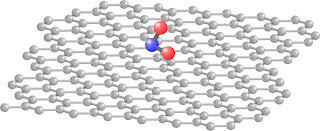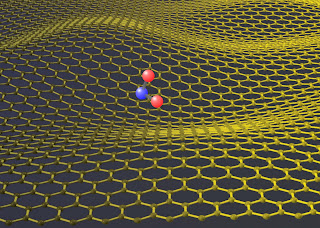Researchers at the University of Manchester have used the world’s thinnest material to create sensors that can detect just a single molecule of a toxic gas.
 | The development of graphene-based devices – which could eventually be used to detect hidden explosives at airports and deadly carbon monoxide in homes – |
They say this sensitivity was unexpected and seems to contradict to the common belief that graphene is extremely chemically inert.
 | The researchers have shown that gas molecules gently attach themselves to graphene without disrupting its chicken wire structure. They only add or take away electrons from graphene, |
Writing in Nature Materials, researchers from the Manchester Centre for Mesoscience and Nanotechnology, say they have demonstrated that graphene-based sensors allow individual events to be registered when gas molecules attach to the surface.
Dr Novoselov, from The School of Physics and Astronomy, says this is clearly observed in changes of the electrical resistance of graphene, which occur as molecules are attaching one by one to its surface.
“This level of sensitivity is typically millions of times higher than for any other gas detector demonstrated before,” says Novoselov. “Graphene sensors are as sensitive as sensors can be in principle.”
Novoselov and Geim believe graphene-based gas detectors could be readily commercially produced using epitaxial graphene wafers, grown in many laboratories around the world and already good enough for this application.
But they stress that further research is needed to make such detectors sensitive to individual gases.
“At present you could not sniff out a flammable substance hidden in luggage because an increase in air humidity would give false readings,” says Geim. “But this is exactly the same problem that all solid-state gas detectors have encountered, and it can be successfully solved through various detection schemes including filters and analysis of a temperature response. We see no reason why the same cannot be done successfully with graphene.
“This is only the first step on the route to commercial graphene-based sensors but the road ahead is clear,” adds Geim. “Once again, graphene has proved itself to be a material with truly remarkable qualities, allowing observations that no other known material could.” ###
Researchers from the Institute for Microelectronics Technology in Russia and the Institute for Molecules and Materials at the University of Nijmegen in the Netherlands, also collaborated on the paper.
For more information please contact Prof Andre Geim, Tel 0161 275 4120, geim@manchester.ac.uk, Dr Kostya Novoselov, Tel 0161 275 4119, kostya@manchester.ac.uk or Alex Waddington, Media Relations Officer, on 0161 306 3983.
Contact: Alex Waddington alex.waddington@manchester.ac.uk 44-016-130-63983 University of Manchester
Solid State Gas Sensors: These sensors are renowned for their very high sensitivity, miniature sizes and low production costs, which have made them ubiquitous and widely used in many applications from fire alarms to air pollution monitors and from alcohol breath tests to detectors of dangerous gases
The operational principle of such sensors is based on changes in electrical conductance of a number of base materials when gas molecules are adsorbed on their surface.
The existing sensors can detect gases in concentrations as small as 1 part per million or less. But higher levels of sensitivity are sought for industrial, environmental and military monitoring of toxic and dangerous gases.
Technorati Tags: Nano or Nanotechnology and Nanotech and Graphene or University of Manchester and Mesoscience or Karl Rove Resignation VIDEO and The Berlin Wall and UCLA's California NanoSystems Institute Partners with Abraxis BioScience to Develop New Nanobiotechnologies















No comments:
Post a Comment